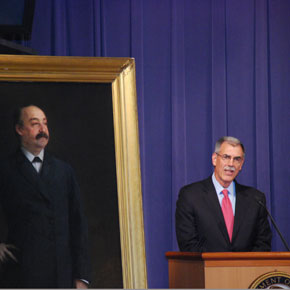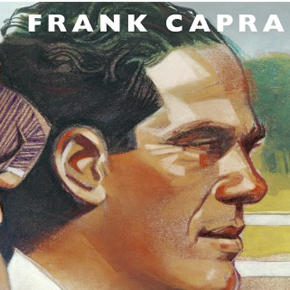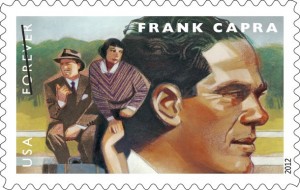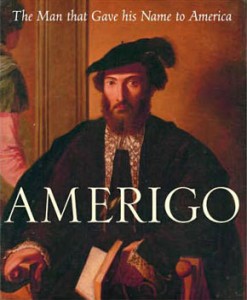At the 52nd Annual Ceremony commemorating Charles J. Bonaparte held on September 12 at the U.S. Department of Justice, keynote speaker, U.S. Solicitor General Donald B. Verrilli recalled his Italian roots to invited guests from the Italian American community. Charles J. Bonaparte, was the 46th Attorney General of the United States and the founder of the Federal Bureau of Investigation.

Donald Verrilli
The ceremony organized by Justice Department Attorney Francesco Isgro, opened with the singing of the national anthems of the United States and Italy by Maria Marigliano and Marco Fiorante, followed with an Invocation by Reverend Lydio Tomasi of Holy Rosary Church.
John DiCicco, Principal Deputy Assistant Attorney General for the Tax Division at the U.S. Departmentof Justice gave the welcoming remarks. He was followed by special remarks given by Minister Luca Franchetti Pardo, the Deputy Chief of Mission at the Embassy of Italy in Washington. Minister Franchetti Pardo noted that Charles Bonaparte, by establishing an investigative force within the Department of Justice laid the groundwork for future international cooperation, noting especially the collaboration between the FBI and Italian law enforcement offcials in combating organized crime and terrorism.
Judge Francis Allegra of the U.S. Court of Federal Claims introduced Solicitor General Verrilli who recalled his Italian roots, noting in particular that his great grandfather Rocco Verrilli, who immigrated to the United States Castelfranco in Miscano, a smal toen in Campania, near Benevento, were more or less contemporaries and shared some similar values. “Bonaparte lived from 1851 to 1921. Rocco lived from 1857 to 1931,” said Verrilli. While they shared dome values the “ihabited entirely different worlds.”
Bonaparte had an distinguished lineage, and attended Harvard College and Harvard Law School. “My greast grandfather Rocco . . . was the son of a sheperd with little in the way of a formal education and left that life as a young man to travel by ship to the United States, taking residence in New York’s Little Italy on Mulberry Street.” Verrilli recounted how his father eventually founded a bank with its offices at 129 Mulberry Street but athough it prospered, it could not survive the 1926 crash. Verrili said that Bonaparte and Rocco “appear to have have been kindred spirits in the things that matter.” Both believed in education and and “both understood in particular the indespensable link between education and effective citizenship.” Rocco put all his eight children to college, including his daughters, said Verrilli. “Bonaparte was a devoted Cathlic and so was Rocco. Bonaparte reportedly loved a good argument and did not pull punches. Neither did Rocco. And both loved his country and were utterly devoted to it.”
I like to think that Bonaparte’s commitment to public service and citizenship would have been an inspiration to my great-grandfather, and a goal he would have had for his descendants. And Bonaparte was indeed a true servant of the public interest – his service fully captured the spirit of his age, the age of Teddy Roosevelt’s progressivism – and he is justly celebrated for his role in laying the groundwork for what would become the FBI, for his fearless trust-busting, and for his lifelong fight against public corruption and in favor of a professional civil service.
Verrillli then talked about the work of Bonaparte before the Supreme Court, noting in particular that he had argued a number of cases on the issue of the fedeal authority to regulate the economy. “Even more impressive to me – given the era in which he lived,” said Verrilli, was Bonaparte’s committment to civil rights.” “Whatever its wells spring, Bonaparte’s commitment to civil rights — like the rest of his record to public accomplishment – fully justifies the honor we bestow on his memory every year,” concluded Verrilli.

Donald Verrilli, Francesco Isgro, John Dicicco, Luca Franchetti Pardo, Francis Allegra
The Bonaparte ceremony was started in 1961 by the late John LaCorte, Sr., founder of the Italian Historical Society of America in New York. At a time when Italians were still struggling with their Italian American identity, John LaCorte sought to promote the accomplishments of Italian Americans. Giovanni Verrazzano , one of the first explorers to reach the New York harbor, was one of them. LaCorte, after many years convinced New York officials to name a bridge in his honor. And then LaCorte came to Washington to promote Charles J. Bonaparte the grand nephew of Napoleon Bonaparte, whose parents were originally from Italy. Through his efforts, Charles Bonaparte has received his due credit for the founding of the Federal Bureau of Investigation, and for his many accomplishments in the U.S. public service arena.
When LaCorte came to Washington in 1961, the late Judge Edward Re had just been appointed by President John F. Kennedy as Chairman of the Foreign Claims Settlement Commission, an office established here at the Department. Judge Re assisted John La Corte in establishing the first ceremony, making him the First Friend of Charles Bonaparte. Judge Re also made sure that then Attorney General Robert F. Kennedy was also present at the ceremony. On that occasion, a granite monument honoring Charles Bonaparte was presented by the Society to the Department of Justice. The monument is now installed at the Pennsylvania Avenue entrance of Main Justice building.

The Friends of Charles Bonaparte, Department of Justice Senior Litigation Counsel Francesco Isgro, together with the Order Sons of Italy, and the Department of Justice sponsored this year’s ceremony, with the support of the OSIA Commission for Social Justice, the National Italian American Foundation and the Lido Civic Club of Washington, D.C.
(CiaoAmerica! Magazine)











